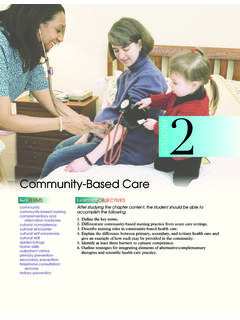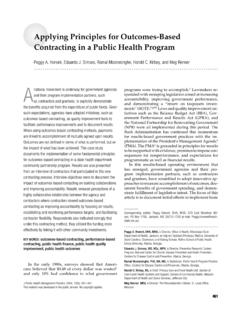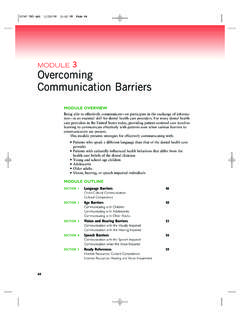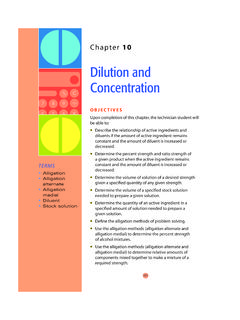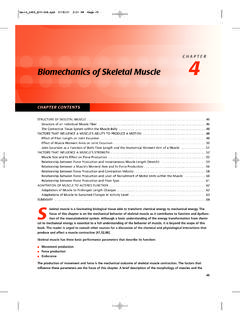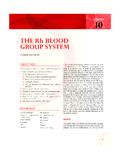Transcription of Foundations of Physical Examination and History Taking
1 Foundations of Physical Examination and History TakingCHAPTER 1 Overview of Physical Examination and History TakingCHAPTER 2 Interviewing and The health HistoryCHAPTER 3 Clinical Reasoning, Assessment, and PlanUNITIThe techniques of Physical Examination and History Taking that you areabout to learn embody time-honored skills of healing and patient care. Yourability to gather a sensitive and nuanced History and to perform a thoroughand accurate Examination deepens your relationships with patients, focusesyour assessment, and sets the direction of your clinical thinking. The qual-ity of your History and Physical Examination governs your next steps with thepatient and guides your choices from among the initially bewildering arrayof secondary testing and technology. Over the course of becoming an ac-complished clinician, you will polish these important relational and clinicalskills for a you enter the realm of patient assessment, you begin integrating the es-sential elements of clinical care: empathic listening; the ability to interviewpatients of all ages, moods, and backgrounds; the techniques for examiningthe different body systems; and, finally, the process of clinical reasoning.
2 Yourexperience with History Taking and Physical Examination will grow and ex-pand, and will trigger the steps of clinical reasoning from the first momentsof the patient encounter: identifying problem symptoms and abnormal find-ings; linking findings to an underlying process of pathophysiology or psycho-pathology; and establishing and testing a set of explanatory through these steps will reveal the multifaceted profile of the patientbefore you. Paradoxically, the very skills that allow you to assess all patientsalso shape the image of the unique human being entrusted to your chapter provides a road map to clinical proficiency in three critical areas:the health History , the Physical Examination , and the written record, or write-up. It describes the components of the health History and how to organizethe patient s story; it gives an approach and overview to the Physical exami-nation and suggests a sequence for ensuring patient comfort; and, finally, itprovides an example of the written record, showing documentation of find-ings from a sample patient History and Physical Examination .
3 By studying thesubsequent chapters and perfecting the skills of Examination and History tak-ing described, you will cross into the world of patient assessment graduallyat first, but then with growing satisfaction and of Physical Examination and History TakingCHAPTER1 CHAPTER 1 OVERVIEW OF Physical Examination AND History TAKING3 After you study this chapter and chart the tasks ahead, subsequent chapterswill guide your journey to clinical competence. Chapter 2, Interviewing and The health History , expands on the tech-niques and skills of good interviewing. Chapter 3, Clinical Reasoning, Assessment, and Plan, explores the clinicalreasoning process and how to document your evaluation, diagnoses, andplan for patient care. Chapters 4 to 17 detail the anatomy and physiology, health History , guide-lines for health promotion and counseling, techniques of Examination ,and examples of the written record relevant to specific body systems andregions.
4 Chapters 18 to 20 extend and adapt the elements of the adult History andphysical Examination to special populations: newborns, infants, children,and adolescents; pregnant women; and older mastery of these skills and the mutual trust and respect of caring re-lationships with your patients emerge the timeless rewards of the health HISTORYAs you read about successful interviewing, you will first learn the elementsof the Comprehensive Adult health comprehensive History in-cludes Identifying Dataand Source of the History , Chief Complaint(s), Pres-ent Illness, Past History , Family History , Personal and Social History ,andReview of you talk with the patient, you must learn to elicit andorganize all these elements of the patient s health . Bear in mind that duringthe interview this information will not spring forth in this order! However,you will quickly learn to identify where to fit in the different aspects of thepatient s AND PURPOSESThe Comprehensive vs.
5 Focused health you gain ex-perience assessing patients in different settings, you will find that new pa-tients in the office or in the hospital merit a comprehensive health History ;however, in many situations, a more flexible focused, orproblem-oriented, in-terviewmay be appropriate. Like a tailor fitting a special garment, you willadapt the scope of the health History to several factors: the patient s concernsand problems; your goals for assessment; the clinical setting (inpatient oroutpatient; specialty or primary care); and the time available. Knowing the4 BATES GUIDE TO Physical Examination AND History TAKINGTHE health History content and relevance of all components of the comprehensive health his-tory allows you to choose those elements that will be most helpful for ad-dressing patient concerns in different components of the comprehensive adult health History are more fullydescribed in the next few pages. The comprehensive pediatric health historyappears in Chapter 18.
6 These sample adult and pediatric health histories fol-low standard formats for written documentation, which you will need tolearn. As you review these histories, you will encounter several technicalterms for symptoms. Definitions of terms, together with ways to ask aboutsymptoms, can be found in each of the regional Examination 1 OVERVIEW OF Physical Examination AND History TAKING5 THE health History Components of the Adult health HistoryIdentifying DataReliabilityChief Complaint(s)Present IllnessPast HistoryFamily HistoryPersonal and Social HistoryReview of Systems Identifying data such as age, gender, occupation, maritalstatus Source of the History usually the patient, but can be familymember, friend, letter of referral, or the medical record If appropriate, establish source of referralbecause a writtenreport may be according to the patient s memory, trust, and moodThe one or more symptoms or concerns causing the patient toseek care Amplifies the Chief Complaint.
7 Describes how each symptomdeveloped Includes patient s thoughts and feelings about the illness Pulls in relevant portions of the Review of Systems(see below) May include medications, allergies,habits of smokingandalcohol,which are frequently pertinent to the present illness Lists childhood illnesses Lists adult illnesses with dates for at least four categories:medical; surgical; obstetric/gynecologic; and psychiatric Includes health maintenance practices such as immunizations,screening tests, lifestyle issues, and home safety Outlines or diagrams age and health , or age and cause ofdeath, of siblings, parents, and grandparents Documents presence or absence of specific illnesses in family,such as hypertension, coronary artery disease, educational level, family of origin, current household,personal interests, and lifestyleDocuments presence or absence of common symptoms relatedto each major body systemThe components of the comprehensive health History structure the patient sstory and the format of your written record, but the order shown should notdictate the sequence of the interview.
8 Usually the interview will be morefluid and will follow the patient s leads and cues, as described in Chapter vs. Objective you acquire the techniques of thehistory Taking and Physical Examination , remember the important differencesbetween subjective informationand objective information,as summarizedin the accompanying table. Knowing these differences helps you apply clini-cal reasoning and cluster patient information. These distinctions are equallyimportant for organizing written and oral presentations about the GUIDE TO Physical Examination AND History TAKINGTHE health History Differences Between Subjective and Objective DataSubjective DataObjective DataWhat the patient tells youThe History , from Chief Complaintthrough Review of SystemsExample:Mrs. G is a 54-year-oldhairdresser who reports pressureover her left chest like anelephant sitting there, whichgoes into her left neck and you detect during the examinationAll Physical Examination findingsExample:Mrs.
9 G is an older, overweightwhite female, who is pleasant andcooperative. BP 160/80, HR 96 andregular, respiratory rate 24, COMPREHENSIVE ADULT health HISTORYI nitial InformationDate and Time of date is always important. You arestrongly advised to routinely document the time you evaluate the patient,especially in urgent, emergent, or hospital include age, gender, marital status, and occu-pation. The source of historyor referralcan be the patient, a family memberor friend, an officer, a consultant, or the medical record. Patients requestingevaluations for schools, agencies, or insurance companies may have special pri-orities compared with patients seeking care on their own initiative. Designat-ing the source of referralhelps you to assess the type of information providedand any possible information should be documented if relevant. Forexample, The patient is vague when describing symptoms and cannot spec-ify details.
10 This judgment reflects the quality of the information providedby the patient and is usually made at the end of the Complaint(s).Make every attempt to quote the patient s own example, My stomach hurts and I feel awful. Sometimes patients haveno overt complaints, in which case you should report their goals instead. Forexample, I have come for my regular check-up ; or I ve been admitted fora thorough evaluation of my heart. Present section of the History is a complete, clear, andchronologic account of the problems prompting the patient to seek care. Thenarrative should include the onset of the problem, the setting in which it hasdeveloped, its manifestations, and any treatments. The principal symptomsshould be well-characterized, with descriptions of (1) location; (2) quality;(3) quantity or severity; (4) timing, including onset, duration, and frequency;(5) the setting in which they occur; (6) factors that have aggravated or re-lieved the symptoms; and (7) associated manifestations.

